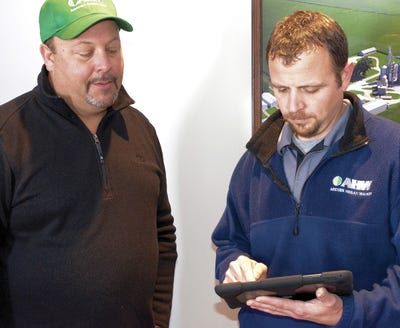April 8, 2015

When the last combine rolls out of the field for Dorn Farms near Momence, Ill., Todd Dorn has a lot of information to deal with. He also knows it’s accurate.
“I know my cost per acre right away, so I can figure my profit for that field,” Dorn says.

Todd Dorn, Momence, Ill., (left) works closely with Justin Blanchette, Arends Hogan Walker, Dwight, Ill., to maximize application of technology on Dorn’s operation. Dorn has a good idea of important cost information for his business very soon after harvest.
Todd Dorn, Momence, Ill., (left) works closely with Justin Blanchette, Arends Hogan Walker, Dwight, Ill., to maximize application of technology on Dorn’s operation. Dorn has a good idea of important cost information for his business very soon after harvest.The operation, which Dorn’s grandfather started in 1943, has fields in both Illinois and Indiana, with the main office sitting just two miles inside the Illinois border.
Dorn likes technology and its ability to help him become more efficient. Spending time on his operation, you learn that he’s open to new ideas and is putting tools like the MyJohnDeere Operations Center to work to maximize his business.
“We have tied the system with our accounting software so we can pull together information quickly,” Dorn notes.
Quick access to cost and profit information can be critical for growers, especially in years when challenging crop prices force them to maximize income opportunities. For Dorn, the additional benefit of the technology is the increased accuracy of the information. “
We have our own grain storage facility, and we have linked the scales into our system, too,” Dorn says. “That way we can match actual weighed field output with the yield maps from the same field.”
A yield map is nothing more than a measure of field variability with a yield component. However, with actual scale information for a field, Dorn can use the software provided in the system he uses to “calibrate” yield information from the field.
“If the scale says we got 1 million pounds of corn off a field, but the yield map says we got 950,000 pounds, we can calibrate that yield map using the scale information,” he notes.
Links that help
That tie to the accounting system is key for managing a large operation. Dorn, who farms with his father, Oliver, and a younger brother, Trent, is working to enhance efficiency across the farm.
“If we can work smarter and cover more ground in fewer hours in a day, that makes a difference,” he says.
Tying the field data gathering systems to the farm’s accounting software makes a big difference. “We know how much we’ve spent on fertilizer, fuel, crop protection and labor on a per-acre basis,” Dorn says.
You might also like:
Justin Blanchette, integrated solutions manager, Arends Hogan Walker LLC, Dwight, Ill., works with Dorn on deploying the technology on the operation and notes: “Tying in that information allows Todd to know his cost of production, which can help him manage his grain marketing program and know when he’s making a profit.”
Blanchette says the application program interface, or API, was developed by John Deere to work with Dorn’s accounting program. John Deere has developed APIs to work with a range of companies to share information back and forth to help farmers maximize the data they collect.
Stacy Reaman, office manager for Dorn Farms, likes the API for the accounting capabilities.
“We used to have to manually enter that information into the system, but now it can be pulled in automatically. It makes my job a lot easier,” says Reaman.
Data at work
As the systems get more integrated, Dorn finds he can do more analysis.
“We’re starting to look at the land we farm and rent,” he explains. “We’re finding we have ground where a few acres in every field is never profitable, no matter what we do. That’s information I can use when talking with landlords.”
Knowing where the profit is, as well as the profit potential for the operation, will be key. The ability to gather up a lot of data efficiently even paid off this spring to help meet USDA requirements for acreage reporting and the new farm bill. “We were able to pull together the information pretty efficiently for the Farm Service Agency office,” says Dorn. Knowing profit per acre quickly, managing field equipment more efficiently and having information available promptly are all key advantages of using a connectivity tool like the Operations Center at myjohndeere.com .
“We’re putting it all together in a one-stop shop,” Dorn says.
Like what you’re reading? Subscribe to Farm Industry News Now e-newsletter to get the latest news and more straight to your inbox twice weekly.
About the Author(s)
You May Also Like






